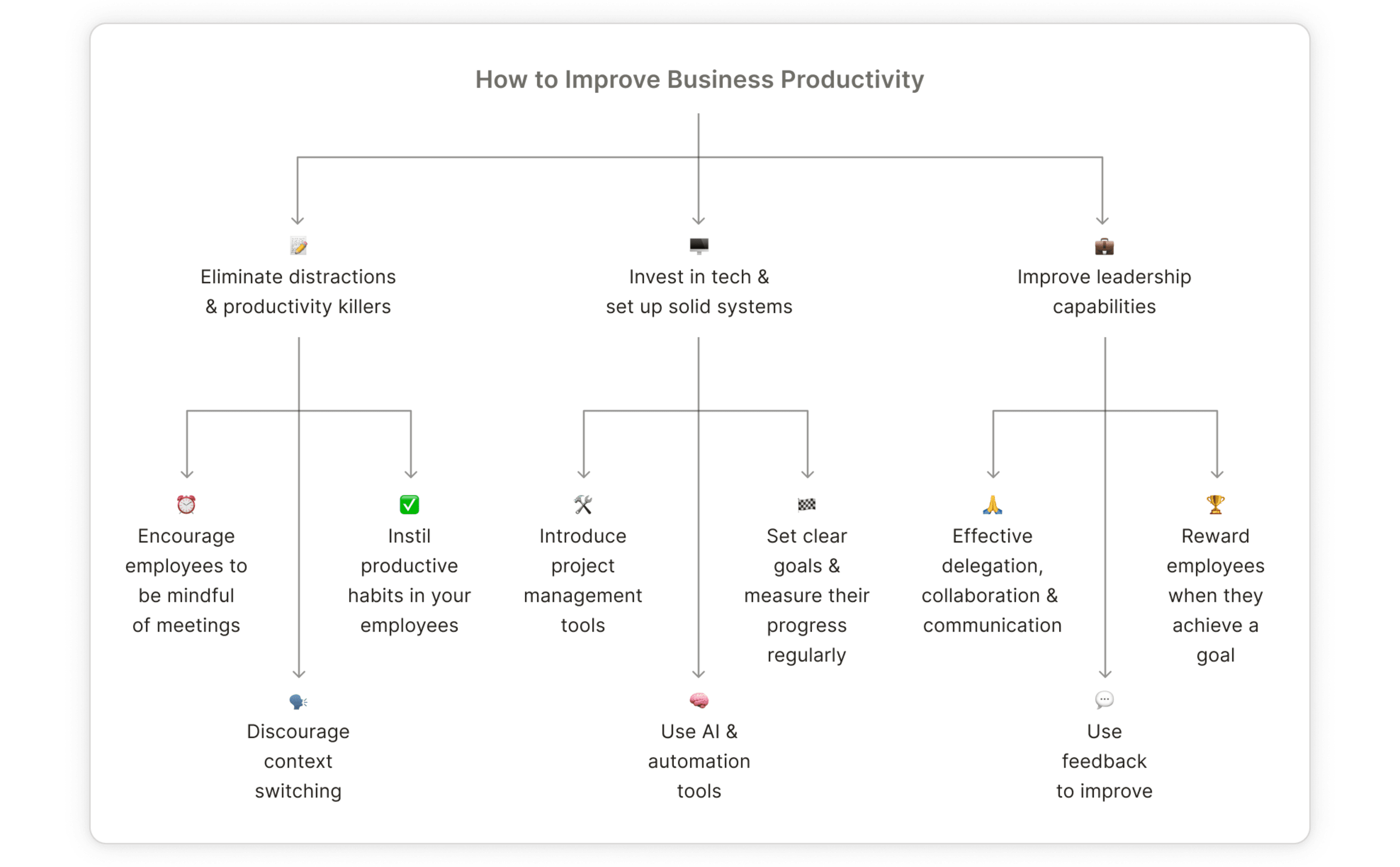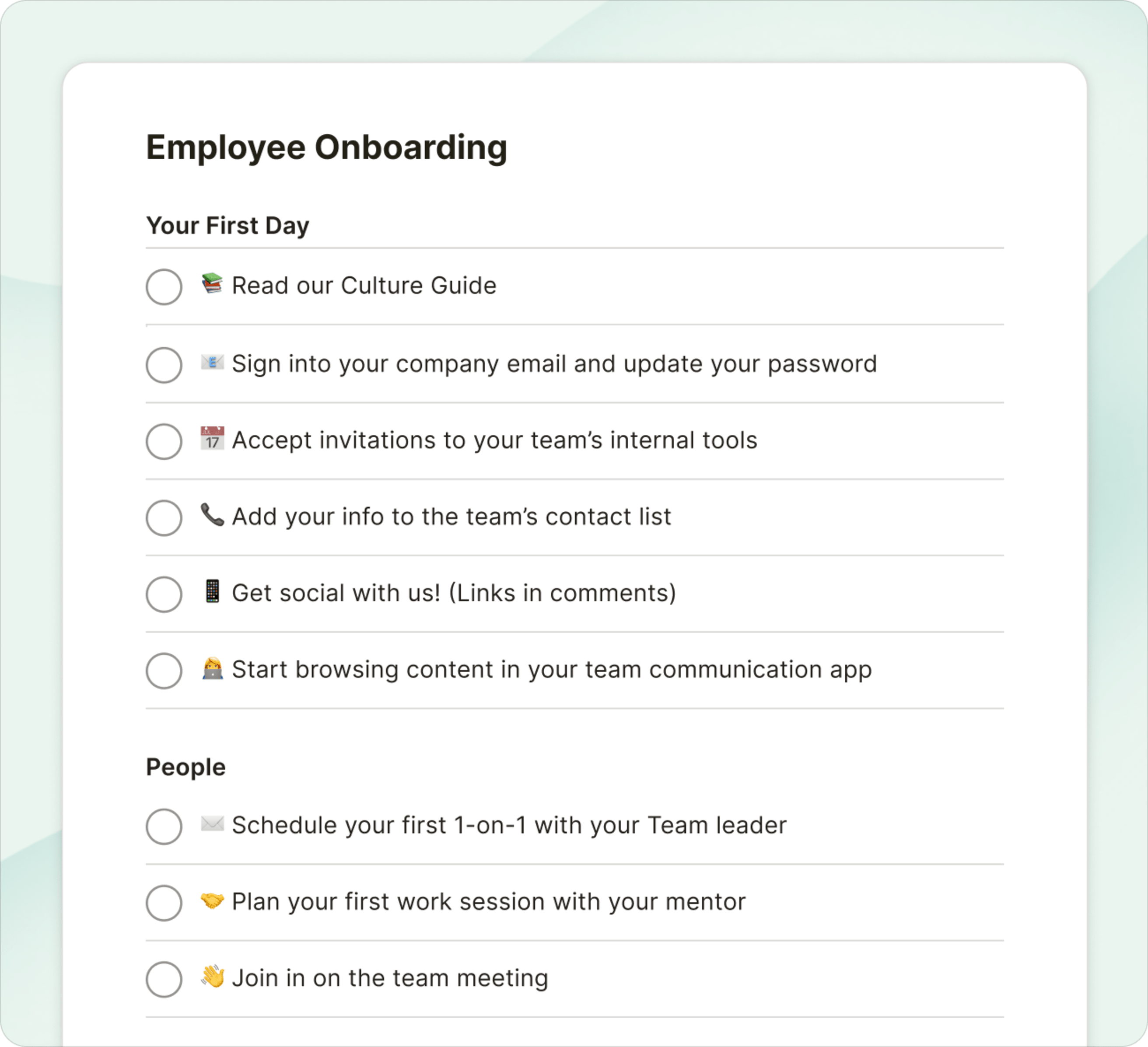If you hear “business productivity” and imagine thousands of buttoned-up corporate employees buzzing with hinged backs on their laptops, you’re not alone. It has that vibe.
And still, workplace productivity is the talk of the town — from small businesses to enterprise companies.
But I have a bone to pick with this buzzword and the advice that surrounds it: It leaves out the humane part of productivity. Sure, you want to improve your company’s bottom line by encouraging your employees to achieve business goals. Who doesn’t? But humans don’t fit in the neat boxes and formulas of labor productivity, outputs produced, gross profits, etc. They extend beyond that.
That’s why generic business productivity advice seems simple on the surface, but fails in real life. It’s easy to shout from the rooftops, “Encourage your team members to get stuff done! Do what you can to increase efficiency! Measure workplace productivity and find ways to improve it even further!”
How do you actually go about doing that, though? How do you eliminate distractions, boost morale in your team, and ensure your employees are fulfilled?
In this guide, I’ll take a more humane approach to business productivity. We’ll cover:
Understanding business productivity
How to measure organizational productivity
Ways to improve productivity in the workplace (methods that are actually actionable!)
What is business productivity?
Put simply, business productivity is the collective measure of your team members’ productivity. Is your team getting stuff done that helps them achieve overarching business goals efficiently? If yes, you have good business productivity.
Let’s break that down. Business productivity has three components:
Employees are flying through their to-do list: At the micro level, your team members should be able to cross off the tasks they set out to do on most working days. Business productivity improves when your team members have a manageable workload and the resources & skills needed to accomplish their daily tasks.
Employees are achieving goals that improve the bottom line: Now, zoom out a little. Every company has overarching goals for increasing profit, improving customer satisfaction, getting funding, or something else entirely. Your team members aren’t just crossing off tasks in a silo, they are doing things that increase your organization’s bigger goals.
Employees are using minimal resources to accomplish their goals: Efficiency is a big component of business productivity. It essentially refers to weeding out the things that shrink your employees’ productivity and doubling down on things that increase them. For example, if your employees are able to focus better (and, by extension, get more quality work done) when there are no meetings, take the initiative to have meeting-free days. After all, it’s no use if your employees improve the bottom line at the cost of stretching your resources. It’ll circle your workplace productivity back to right where you started.
You’ll understand business productivity even better once you hone in on the differences between workplace productivity and individual productivity.
Differences between individual productivity vs. organizational productivity
When most people hear “productivity,” they think of individual productivity. They want to get their important tasks done in a day, which can include everything from writing a proposal (a business task) to picking up kids from school (a personal task).
Individual productivity encompasses someone’s personal and professional life. How much one person can do is impacted by their time management skills, goal-setting framework, motivation, and personal habits.
Organizational productivity, on the other hand, is looking at only the professional side of things. You’re not just looking at how much one person is getting done, but how much your entire team is getting done collectively. Along with individual skills, company culture, technological advancements, collaboration environment, and leadership skills also influence business productivity.
Individual productivity | Business productivity |
|---|---|
It’s the measure of productivity for one individual | It’s the measure of productivity for your entire team and/or company |
Includes personal and professional tasks | Includes only business-related tasks |
Influenced by a person’s time management skills, motivation, personal habits, etc. | Influenced by individual skills and company culture, collaboration environment, leadership, technology, etc. |
Increasing individual productivity will have a domino effect on business productivity. If your team members are able to finish their personal tasks with your help, it will ease their minds, and they will provide more quality work for the business.
For example, encouraging employees to invest in courses related to their jobs might seem like a cost against business productivity. Team members are taking time away from the company to strengthen their resume and advance their career. But in the longer run, it’s an investment because they’ll apply those skills in the work they do for you. It will also boost your team’s morale and motivation.
Now that you fully understand business productivity, let’s tackle how to measure it.
How to measure workplace productivity
Measuring business productivity should be simple, right? You evaluate how efficiently your employees are performing their tasks to achieve business objectives. Output divided by input. Easy.
But hardly anyone is doing only repetitive tasks anymore. The Industrial Revolution has ended, and so should this measure of business productivity. The value of someone’s work (aka, the ‘output’) isn’t straightforward to measure.
There are other fancy formulas to measure business productivity — like measuring revenue per employee. It’s calculated by dividing your total revenue by the number of employees. But even this calculation is only measuring how effectively you’ve used human resources. It’s not understanding whether your customers are satisfied, doesn’t consider your profit margins, and doesn’t measure employee or customer retention rates.
The conclusion: To accurately measure business productivity, you need a multifaceted approach that encompasses all areas of your business.
The simplest way to do this is by setting OKRs for your team members. At a company level, this involves the following steps:
Setting specific company goals to achieve in a quarter. For example, getting 2,000 paid customers.
Dividing how each sub-team will contribute to this goal. For example, the customer success department will focus on converting free buyers to paying ones by highlighting new features, doing personalized calls, etc.
Further assign goals and KPIs to each individual employee. For example, a customer success team member can have the objective of bringing in 200 paying buyers in the quarter.
In the end, measure each employee's success. Some teams might outperform, and others might underperform. For example, if marketing couldn’t achieve its objectives, it would impact overall business productivity.
Find why teams and individuals outperformed and underperformed. Double down on the factors that helped teams and individuals outperform and eradicate the reasons for underperformance. For example, if you find paid ads have worked excellently for you, invest more in them.
OKRs aren’t your thing? I get it! You can also measure company productivity using the following methods:
SMART goals (smart, measurable, achievable, relevant, time-bound): Set company-wide goals that are Specific, Measurable, Achievable, Relevant, and Time-Bound.
WOOP goals (wishes, outcome, obstacles, plan): Note down your Wishes for company productivity, think of what the Outcome would be when you achieve your wish, predict the Obstacles that may arise in achieving that outcome, and create a Plan to fight the obstacles.
V2MOM framework (vision, values, methods, obstacles, measure): Decide your Vision for company productivity and define how it aligns with your Values. Then, jot down specific Methods to turn your vision into reality. Predict the Obstacles that may arise so you can dodge them. In the end, also get specific about how you’ll Measure the success of your vision.
Note
All methods of measuring productivity will have simplistic steps (in theory). In reality, things aren’t always so black and white. Many things are unmeasurable (like team motivation). Some things can’t be put on a spreadsheet — like your team’s mental health. That’s the human part of business productivity. It’s not neat & tidy and can’t be boxed into mathematical accuracy. But, you can still measure some aspects of business productivity and rely on gut feeling and experience for the rest. Don’t look at numbers in isolation.
That said, there are still ways to improve your business productivity — both the measurable and the unmeasurable.
How to increase your business productivity

Increasing your business productivity isn’t a one-off task. You need to constantly keep at it to keep your team members happy and productive. Largely, improving workplace productivity falls into three buckets:
Eliminating distractions and productivity killers
Investing in technology and setting up solid systems
Improving leadership capabilities
Let’s dive deeper into what you can do to increase business productivity with each of the above three pointers.
Note
⚠️ Remember: You don’t have to fill all three buckets simultaneously. There are various actionable tasks listed below for each category, but the important thing is sticking to these activities. Tackle one thing at a time. Improve one area and move on to the next. Keep monitoring the tasks in these buckets every so often to determine which needs filling.
Eliminating distractions and productivity killers
The easiest way to increase business productivity is to remove things that hamper it. Your company may have specific distractions or job-specific situations, but here are the most common productivity killers that you should nip in the bud:
1: Encourage employees to be mindful of meetings
Reclaim AI recently surveyed 1,300 professionals on their meetings and found that:
On average, employees spend 37% of their time in meetings
The average annual cost of meetings per employee is $29,129
Out of these, 52.9% are recurring meetings
These numbers alone might not appear shocking. But compare this with another one of their findings — which confirms that only 12.4% of company executives fully understand their team members’ meeting load.

If you think a few extra meetings don’t impact your business productivity all that much, think again: MIT Sloan conducted an experiment in which they found that having three meeting-free days in a week shot up employees’ productivity by a whopping 73 percent.
Meetings are great, but they often interrupt your employees’ deep work sessions — reducing their productivity. This adds up for every team member and slashes your workplace productivity by a lot. What’s even worse? Meetings feel productive, even when they can hinder the actual application of meaningful work.
Consider doing a meeting purge like Spotify: In 2023, the company removed all recurring meetings with more than two people and reinforced their no-meetings on Wednesdays rule. The leaders were asked to encourage their team members to say no to meetings.
And when you are putting meetings on your employees’ calendar, pause and ask if they have a clear agenda, purpose, and time limit. This will ensure every time you spend on meetings is valuable.
2: Discourage context switching
Context switching is when your focus is fragmented. Imagine jumping on a call with customer A for 15 minutes, replying to customer B’s email for 5 minutes, and then having an internal company meeting for 30 minutes. That’s a lot of tasks done, but it’ll likely leave you feeling drained. Plus: You won’t make that much progress in any of the three tasks.
Every ding of a Slack message, the swoosh of a social media notification, and the buzz of a news event kills your employees’ productivity. Once you get distracted, re-focusing can take up to 23 minutes and 15 seconds, according to a study by the University of California, Irvine.
Help your employees set up their days in ways that allow for little to no context switching. This can mean:
Blocking certain parts of the day for deep work
Slotting all customer and internal meetings in one or two days
Jot down tasks from your brain into Todoist quickly using Quick Add
Setting a specific time to deal with admin tasks like responding to emails
Note
💡 Want to learn more? Read how context switching can sabotage productivity.
3: Inculcate productive habits in your employees
You can eliminate distractions at the company-level, but some distractions — like social media and procrastination — are rooted in personal habits. The best way to wring these out of your team members’ systems is to help them gain a deeper understanding of productivity and productivity methods.
You could start by:
Helping your employees understand which productivity method works best for their personality by taking this quiz
Regularly check in for productivity killers in your conversations with them and find ways to help. For example, if they mention lots of noise in their neighborhood, consider gifting them noise-canceling headphones
If you work remotely, teach employees how to navigate remote work using productivity techniques like the Pomodoro technique, having a separate workspace, and effective communication principles
In the end, inculcating productive habits in your team members depends on identifying your employees’ personalities, regularly discussing their productivity struggles, and offering personalized solutions based on your knowledge of the person, their job, and their personal life. Be an empathetic and supportive leader and productivity will follow.
Investing in technology and setting up solid systems
The second aspect of improving business productivity is inculcating goal-setting and technology. Factory workers have machines that help them finish the same task in less time. You and I have tech and organizational tools. Here are some ways to use technology and goals to your advantage:
1: Introduce project management tools
Big projects need to be managed using a project management tool. Organizing all the tasks you have to do — especially for multiple projects — under one long list can become incredibly overwhelming.
Take Todoist. In it, you can:
Use a Kanban, list, or a calendar layout
Divide projects into sections so it’s easier to digest
Break down one big task into various sub-tasks (makes the next step clear)
Set reminders and deadlines for each sub-task so nothing is ever missed
Communicate and share any doubts, questions, or URLs using comments
Assign tasks to team members so everyone knows who’s responsible for what
Note
💡 Continue reading: A Quick(ish) Guide to Completing Any Project in Todoist
Productivity tools help you organize your projects and inform everyone what needs to be done. This alone can have significant improvements in your productivity. But while you’re at it, don’t just use your organizational capabilities to manage a project. Think of the repeatable tasks you have in your team and create systems to complete them.
For example, create an onboarding packet for new employees that helps them learn everything from company culture to job-specific requirements. This will ensure you and your team aren’t all frazzled when a new team member enters the company.

Find ways to constantly streamline your workflows and set up systems for repeatable tasks. This will reduce your employees’ mental overload and increase their productivity.
2: Set clear goals and measure their progress regularly
“I wish what I needed to do was more vague,” said no one ever. It’s impossible to urge employees to improve their productivity if they don’t know what they’re striving toward. 75% of employees in the Reclaim AI survey said they believe it’s important to set goals and monitor metrics around team productivity.
Having goals can be as simple as sticking to a project deadline or as big as achieving the quarter’s KPI. The small and the big work together to improve day-to-day business productivity.
Most companies set quarterly KPIs to establish clear goals, have a deadline to achieve them, and monitor their progress. If you have set them up already, great! If they don’t work for you, try creating SMART goals for your team. In both of them, block time to monitor individual employees’ progress and spot areas of improvement.
Remember, the aim is to provide a clear direction for your team to work toward. If the goals you’ve set evolve, so should your success metrics.
3: Use AI and automation tools to improve your productivity
Technological advancement is nothing new. It made factory workers more efficient and the same goes for knowledge workers.
Zapier did a survey that found that 94% of workers perform repetitive, time-consuming tasks in their roles. And 65% are less stressed after automating manual tasks.

Jot down the manual tasks that your team has to do on a recurring basis and find if there are tools that can help them automate these tasks or do them more efficiently at scale.
There might be some generic automation tools that help improve productivity (like setting up automations using Zapier) and some other more job-specific tools (like using Zendesk for customer service teams to handle tickets at scale).
Take the company, Conagra: It uses Galileo HR AI assistant to prepare a business case to invest more in leadership development programs because the HR could quickly ask the tool how much they’re spending on these programs currently per leader. Not just this: The company also uses Galileo for talent development and answering employee questions at scale.
Find AI and automation tools that can help your employees improve their efficiency and invest in them. That upfront cost will give you a positive return on investment for the long term.
Improving leadership capabilities
Leadership is one of those soft skills that is difficult to measure accurately but has a clear and broad impact on business productivity. A great leader can foster motivation and morale among their team to improve workplace productivity, and a poor leader can have the opposite effect. Here are the core leadership tasks to focus on to improve organizational productivity:
1: Practice effective delegation, collaboration, and communication
Delegating is easy. Delegating well is a different story. As a leader, you must know how to:
Identify tasks that need to be delegated
Communicating what needs to be done clearly
Choose the right person for handling the responsibility
Providing guidance without handholding and micromanagement
Sharing all the resources your team members might need to finish a task
Collaborating with team members doesn’t mean you hand over a task to them and never look at it. You need to help them figure out the ropes and also push them to take uncomfortable challenges when needed. Delegation’s purpose is to advance your employees’ skills and reduce your workload at the same time — that’s how you improve business productivity.
Note
💡 Learn more: How to Delegate
2: Use feedback to help improve workplace productivity
Feedback works in both directions to increase overall business productivity: You need to provide feedback to your team members to improve their skills and they need to offer the same to you so you can foster a better company culture.
Take Shopify: They introduced the concept of dual-track promotions to help individual contributors who don’t want to go into management progress meaningfully in their careers. This would’ve never been possible if Shopify’s leaders had not listened to the feedback and needs of its employees.
As leaders, you need to learn to provide kind, specific, and constructive feedback to your employees. Ideally, you’ll offer this feedback on a regular basis — whether off-handedly on a call when someone displays their work and/or in dedicated sessions designed to help workers improve. It depends on your company’s culture.
Either way, the goal is to offer and listen to feedback from your team members. Knowing specific areas that need to be worked on is an instant productivity enhancer. There’s clarity on what to focus on and a clear picture of what that looks like.
3: Reward employees when they achieve a goal
It’s easy to forget to pat your team members on the back when everything is going right. But this could cost you big time: A survey of 2,000 employees found 46% have left a job because they felt unappreciated. And 63% said they feel underappreciated on a daily basis. Ouch.
Incentives have always been a hit in improving business productivity. They motivate team members to work harder and feeling recognized is always nice. When someone on your team does a good job, pause to appreciate them.
You can issue tangible rewards for achieving long-term goals and KPIs — like sales teams having additional variable income depending on the leads they bring in.
But employee recognition doesn’t always have to be monetary: Buffer uses Taco to praise someone for their work. These can be redeemed into prizes like company swag.
Remember compliments, rewards, and recognition are just as important facets of improving business productivity as constructive feedback. Don’t forget to thank your employees for the work they’re doing — make it a habit.
Business productivity isn’t a one-time endeavor
Improving business productivity isn’t a project you can tackle once and then surrender to never look at again. If you do, you’ll face diminishing returns on your efforts. The thing with workplace productivity is that it’s always a work-in-progress. If you’ve tackled creating clear goals today, you need to work on giving effective feedback tomorrow.
Keep workplace productivity on the back of your mind always. This will allow you to approach productivity with an open mind and keep your eyes open for areas of improvement.

